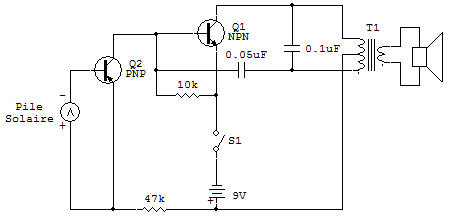

"Crack of Dawn" Alarm Clock

Many of these experiments are very practical, you may want to build one or more of them in a permanent form. Try each circuit and think of ways you might be able to use them.
Do you need a good "crack-of-dawn" alarm clock or a good light alarm? Here it is. This circuit draws no battery current when in darkness, but when light strikes the Solar Cell the alarm gives out a steady tone. Battery current during alarm operation is only about 2 mA, so it is a Battery saver at all times.
You can consider this circuit as two separate or independent circuits. The 2SC is a standard pulse-type audio oscillator that uses a center tapped Transformer to obtain regenerative feed back. The collector-to-emitter (C-E) resistance of the 2SA is controlled by the Solar Cell. In darkness the Solar Cell does not generate any base-bias for the 2SA so its C-E resistance is very high (approaching an open circuit in effect). At this time insufficient current is available as base-Ma's for the 2SC so it is also OFF.
When light causes the Solar Cell to generate base-bias current for the 2SA, the 2SA turns ON, causing a low resistance between C-E. This allows base-bias current to flow to the 2SC to turn it ON so it can oscillate.
This project is a good one to build up and leave connected when you put this kit away in a drawer. There is no need to worry about Battery drain while it is in the dark drawer, but if anyone opens your drawer you'll know it.
